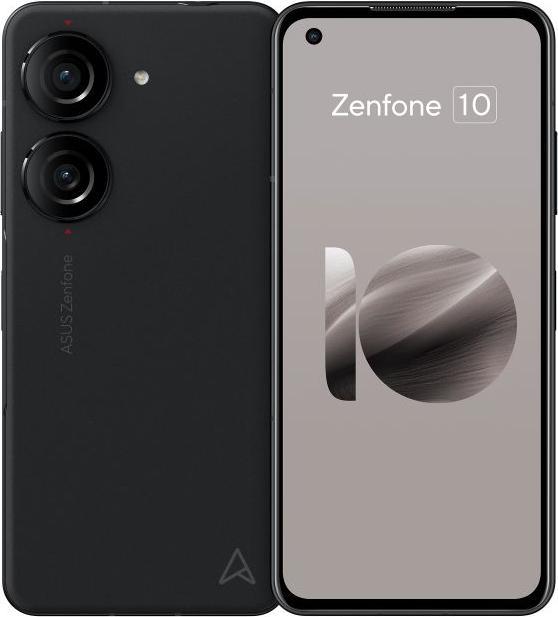

Asus Zenfone 10 review: good smartphones can be small
A small smartphone with top-of-the-range features? Asus delivers with the Zenfone 10 – at least when it comes to display size.
5.92 inches will still be too big for some purists. Among the current top smartphones, the Zenfone 10 is still the smallest model and almost unrivalled in its niche. However, there are competitors that are wider, but thinner and slightly shorter.

The slimmest, but not the thinnest smartphone
With a 6.1-inch display, the Samsung Galaxy S23 sounds bigger than the Zenfone 10, but most definitely isn’t.
- Galaxy S23: 146.3 × 70.9 × 7.6 mm, 168 grams
- Zenfone 10: 146.5 × 68.1 × 9.4 mm, 172 grams
If it were only about dimensions, you’d have to choose between narrower and thicker or wider and thinner. 0.2 millimetres in height and four grams in weight are negligible.
A snazzy small display and grippy back
There have been few changes in the Zenfone 10’s design. The back is still made of a soft and grippy plastic. The main changes are the imprinted lettering and the logo. I like the material, although it isn’t fully impervious to fingerprints. If you’re bored with black, Asus also offers the phone in white, red, green and blue. In terms of water resistance, the casing is IP68-certified. In other words, it can survive for 30 minutes in two metres of water without being damaged.
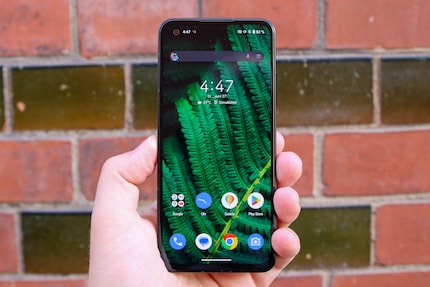
Source: Jan Johannsen
On the front, the 5.92-inch AMOLED display leaves nothing to be desired.
- Resolution: 2400 × 1080 pixels (Full-HD+)
- Brightness: 1100 Nits
- Refresh rate: up to 144 hertz (in games)
- DCI-P3 colour space coverage : 112 per cent
- Colour difference: Delta-E < 1
In high-performance mode, the Zenfone 10 outclasses them all
With the Snapdragon 8 Gen 2 and up to 8 or 16 gigabytes, the Zenfone 10 promises plenty of power. When I start Geekbench 6, the smartphone automatically activates its high-performance mode. In this benchmark it achieves similar values as the ROG Phone 7 in X mode. It outperforms the Galaxy S23 Ultra, the Moto Edge 40 Pro and the Sony Xperia 1 V.
If I let the Zenfone 10 regulate itself dynamically, it tries to find a suitable compromise between performance and power saving. I don’t notice any disadvantages here, only lower test results.
The Zenfone 10 has enough power for its tasks in any case.
Depending on the model, you can’t expand the 128, 256 or 512 gigabyte internal storage with a microSD card. Still, at least there’s room for two SIM cards.
Zen UI with practical features and only two major updates
Asus ships the Zenfone 10 with Android 13. The manufacturer provides Google’s operating system with its Zen UI user interface. It contains numerous functions and tools that aren’t part of Android’s standard and partly only appear with this smartphone.
Some features are designed to make the small smartphone even easier to use with one hand. This includes one-handed mode, for example. Swipe down on the lower edge of the display and the smartphone only uses that half. I can reach everything easily using just one thumb.
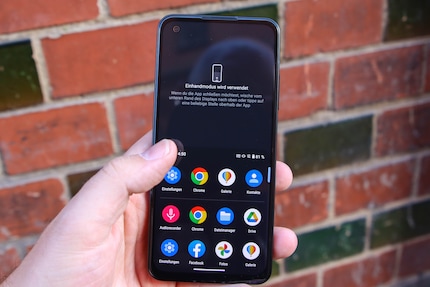
Source: Jan Johannsen
In a similar vein, there’s EdgeTool. On the home screen, it’s discreetly displayed on the right edge as a small, transparent bookmark. Dragging it into the display, the apps or quick settings I selected appear.
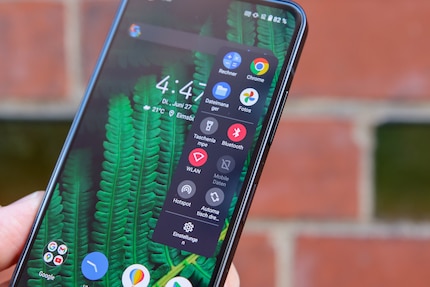
Source: Jan Johannsen
The power button, which Asus calls a smart button, not only houses the reliably functioning fingerprint sensor. I can also double or long press it to perform an action. The default settings are voice input and power off. But I can select other actions and apps in the settings. Also, I can swipe my finger over the smart button to get to the top or bottom of a web page. When the Zenfone 10 was introduced, it was set to include website scrolling. But either the function isn’t yet integrated into the software or my fingers aren’t nimble enough for it.
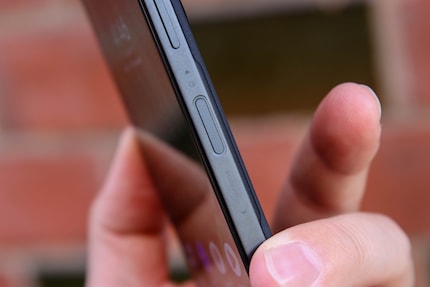
Source: Jan Johannsen
Other quality of life features include double or triple tapping the back for an action or Quick Shot. Double-pressing the volume button opens the camera, starts a video recording or instantly takes three photos.
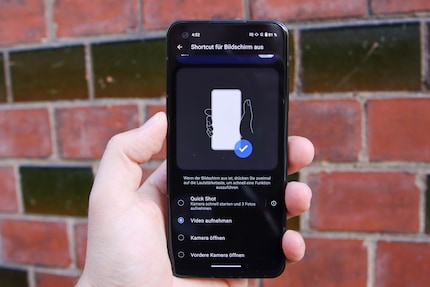
Source: Jan Johannsen
Among other things, Game Genie is supposed to ensure that you aren’t interrupted by minor notifications while gaming. And Asus’ Phone Clone helps you transfer from your old device. You can supposedly also transfer more data now than previously – but the manufacturer didn’t reveal exactly which data they meant. Screenshots can be extended in small steps. But you can’t record full content at once.
Asus also offers in-house icons for the quick settings. They’re smaller than Android’s standard. As a result, six and not just four icons are visible after one swipe from the top edge.
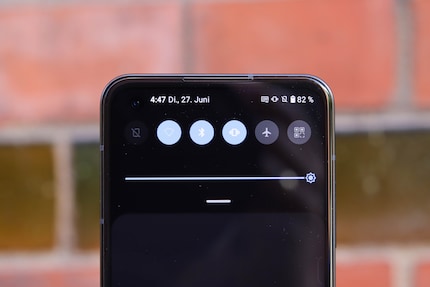
Source: Jan Johannsen
There’s also searching in Asus’ gallery app, but it’s still being tested and only available in English. In it, an AI recognises content in your photos, allowing you to search for specific things. For this, images don’t even have to go to the cloud. All data should remain on the smartphone.
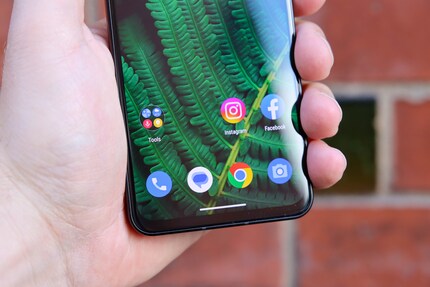
Source: Jan Johannsen
The biggest drawback of the Zenfone 10’s software are the promised updates. Asus wants to deliver four years of security updates, but only guarantees two major Android updates. While four years is the current standard, only two Android updates is rather meagre. You’ll have to hope that Asus changes its mind in two years with Android 16.
Wireless charging for a small battery
One small novelty is that the Zenfone 10 supports wireless charging. The 4300 mAh battery accepts up to 15 watts via the Qi standard. One full charge from zero takes about two hours. Cable is still fastest. HyperCharge supports up to 30 watts from PD 3 power supplies. This reduces your wait to just over an hour.
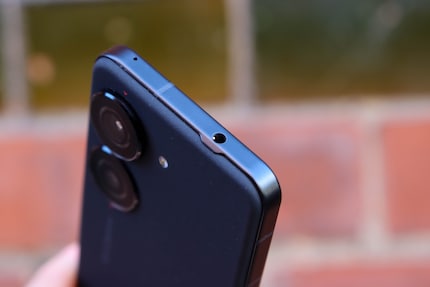
Source: Jan Johannsen
The battery seems small, but is supposed to last up to 12.9 per cent longer than in the Zenfone 9 thanks to more efficient hardware, among other things. In any case, I get through the day well with the Zenfone 10. The small battery isn’t a problem. It isn’t even that small. The Galaxy S23 has to make do with 3900 mAh and only accepts a maximum of 25 watts via cable.
Only room for two cameras
The small size is noticeable with the cameras. The Zenfone 10 only has room for two cameras. The 50-megapixel main camera sensor follows Sony’s IMX766, remaining identical to the Zenfone 9. The resolution of the ultra-wide-angle camera has increased by one to 13 megapixels. Also, the viewing angle has increased by seven degrees to 120 degrees. The front-facing camera, on the other hand, has significantly increased in resolution with 32 megapixels. The predecessor had only twelve megapixels.
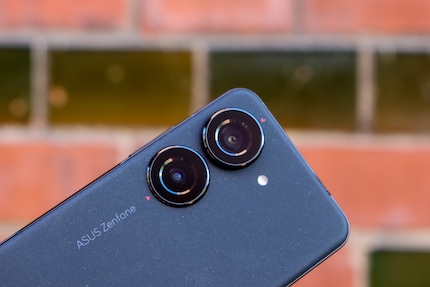
Source: Jan Johannsen
Colours
The new, old sensor of the main camera still delivers highly detailed images and natural-looking colours.

Source: Jan Johannsen
Wide angle and zoom
The ultra-wide-angle camera follows suit. Detail accuracy and colour reproduction are on par with the main camera. Only the blue of the sky shows a difference in favour of the 50-megapixel sensor. The ultra-wide-angle camera barely displays any distortion. The steep slope of the buildings on the left edge is more a general problem of perspective.

Source: Jan Johannsen

Source: Jan Johannsen
Zoom is only available digitally in the Zenfone 10. Twofold magnification is still presentable on the smartphone itself and can be used for social media posts. On the other hand, when I view the image on a computer in full resolution, the weak details are noticeable. These are also clearly visible on the smartphone display at 8x zoom – the maximum.

Source: Jan Johannsen

Source: Jan Johannsen
Portrait mode
The main camera offers a portrait mode that blurs the background. Colour reproduction and the level of detail match conventional lens pics. Also, it makes me come out well. Glasses, beard and clothes are all well recognised.

Source: Jan Johannsen
I can adjust the focus point and blur level in Asus’ gallery app afterwards.
Night
The automatic system already manages a well-lit dark image with the main camera. Night mode improves the exposure a bit and provides a greater level of detail. Still, the nighttime setting is a recognisable aesthetic element.

Source: Jan Johannsen

Source: Jan Johannsen
However, there are situations where night mode makes the shot too bright for me. Technologically, it may be impressive how much the image can be brightened. Aesthetically, it’s a disaster.

Source: Jan Johannsen
With the wide-angle camera, the photos remain very dark in automatic mode. Here, night mode provides a clear improvement in exposure and sharpness.

Source: Jan Johannsen
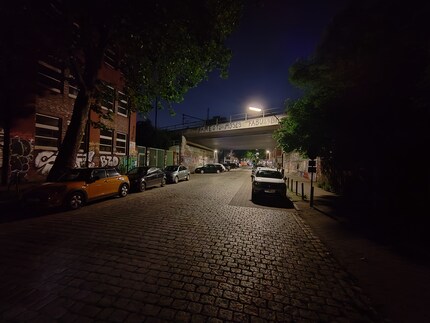
Source: Jan Johannsen
Selfies
The front-facing camera turns 32 megapixels into eight in practice. This pixel binning supposedly increases light sensitivity by 67 per cent and reduces image noise by 50 per cent compared to the Zenfone 9.
In daylight, I’m satisfied with the result. I’m clearly recognisable in the selfie below. It’s detailed and the colours look natural. The background is discreetly blurred so attention remains on the subject.

Source: Jan Johannsen
The Zenfone 10 also debuts a night mode for selfies. Compared to the predecessor, a clear improvement can be seen in the dark. Still, it’s not enough for great self-portraits at night.

Source: Jan Johannsen
Verdict: nice and compact, but not yet perfect
When it comes to finding a great smartphone that’s as compact as possible, the Zenfone 10 definitely belongs at the top of the list – but I’m not fully convinced.
The size is ideal and has no negative impact on performance. On the contrary: in high-performance mode, the Zenfone 10 outdoes the competition. The display is nice to look at and the numerous buttons and functions assist with one-handed operation.
The battery life is great, charging times could be a bit faster. The camera delivers decent pictures, but isn’t outstanding. On the software side, Zen UI offers practical additions to standard Android, but it’s marred by a short update period.
Despite all my praise for the Zenfone 10, the update promise is a big flaw for me. The short time frame for updates makes me more inclined to reach for the minimally larger Galaxy S23 when looking for a small top smartphone.
Header image: Jan Johannsen
When I was but a young student, I'd sit in my friend's living room with all my classmates and play on his SuperNES. Since then I've had the opportunity to test out all the newest technology for you. I've done reviews at Curved, Computer Bild and Netzwelt, and have now arrived at Galaxus.de.






